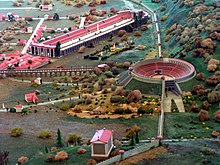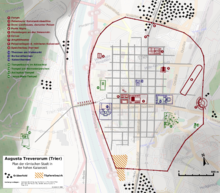Temple at Herrenbrünnchen

The temple at Herrenbrünnchen was a monumental podium temple above the temple district in the Altbachtal near the Herrenbrünnchen and the Roman amphitheater in Trier , the ancient Augusta Treverorum .

Discovery and excavation
After the discovery of several architectural parts from the late 1st century above the temple district in Altbachtal, an excavation was carried out on the grounds of the Charlottenau winery in 1909/10 by the Rheinisches Landesmuseum Trier . The remains of a monumental podium temple were uncovered, the podium measuring 65 × 23 m. The temple was probably constructed as a prostyle with a portico in front. He had a detached African-shaped for the preparation of a monumental cult image Adyton . A monumental staircase that led to the temple in two paragraphs, one entered the vestibule of the temple. In the lower section of the stairs there was an altar podium that was accessible from the landing. The podium foundation had walls up to 4.10 m thick. Architectural parts found allow a temple front to be reconstructed with six 15 m high columns that carried architraves and gables. There is a certain similarity to the largely preserved Maison Carrée in Nîmes .
The temple, facing north-northeast with a view of the amphitheater, was embedded in a slight northeast slope and formed a monumental conclusion in the east of the Roman city. In the early days of the Colonia , both buildings were also outside the Pomerium , so that, unlike the Forum, a main temple, for example for the Capitoline Triassic , cannot be expected here. A few fragments of cornices and architraves were found near the south-western narrow side, which can be assigned to a total of four arches. These may have belonged to a portico that was probably located to the south behind the temple. Three of these arches are exhibited in the Rheinisches Landesmuseum Trier.
According to a tradition from the 10th century, the bishop Eucharius is said to have baptized numerous people at this point . The site is later referred to as the Baptistery or Taufborn . In contrast to the temple district in the Altbachtal, to which no noteworthy Christian finds can be assigned, a Christian place of worship could perhaps have followed the pagan temple here. However, there is no archaeological evidence for this. Apart from a sign, nothing of the facility is visible above ground, the temple foundations are in the gardens of today's single-family houses.
Finds
Several lavishly designed limestone pillars in the square building of Trier Cathedral , which were used to replace granite pillars that broke after a fire in the 5th century, may come from the temple at Herrenbrünnchen as spoils , since no other such monumental temple building with a comparable pictorial program can be proven in the city area. The capitals consisted of three-layer limestone and had a height of 1.65 m with a lower diameter of 1.25 m. They are decorated with acanthus leaf wreaths. Representations of a snake on a volute and a similar representation on a block of the associated portico suggest a spring sanctuary. However, there are no more precise references to the deity worshiped here.
In addition to the architectural parts, there are significant finds from inscriptions from the temple at Herrenbrünnchen. The priests (haruspices) of the Civitas Treverorum have dedicated an altar with a base and cornice to the memory of their masters and fathers. Another inscription was placed by an imperial freedman on Mars Victor Augustus as a redemption for a vow. A list of 60 names carefully carved into four limestone blocks probably denotes the members of a cult society. The coins found date from the beginning of the 2nd century AD to the 4th century, whereby the mass comes from the 3rd century.
literature
- Heinz Cüppers : Trier - temple and spring house at Herrenbrünnchen. In: H. Cüppers (Ed.): The Romans in Rhineland-Palatinate. Licensed edition, Nikol, Hamburg 2002, ISBN 3-933203-60-0 , pp. 592f.
- Sabine Faust: Pagan temple districts and cult buildings. In: Alexander Demandt, Josef Engemann (ed.): Konstantin der Große. Emperor Caesar Flavius Constantinus . Philipp von Zabern, Mainz 2007, ISBN 978-3-8053-3688-8 , p. 329.
- Marcello Ghetta: Late Antique Paganism. Trier and the Treverland. Kliomedia, Trier 2008, ISBN 978-3-89890-119-2 .
- Karl-Josef Gilles: Temple districts in the Trier region. In: Religio Romana. Paths to the gods in ancient Trier. Exhibition catalog Rheinisches Landesmuseum Trier 1996, ISBN 3-923319-34-7 , p. 76 u. Cat.-No. 37 ( Series of publications by the Rheinisches Landesmuseum Trier 12).
- Erich Gose: The temple at Herrenbrünnchen in Trier. In: Trier magazine for the history and art of the Trier region and its neighboring areas 30, 1967, pp. 83-100.
- Markus Trunk : Roman temples in the Rhine and western Danube provinces: a contribution to the architectural-historical classification of Roman sacred buildings in Augst. Augst 1991, ISBN 3-7151-0014-1 , pp. 219-222 ( research in Augst 14).
Web links
Individual evidence
- ^ Religio Romana. Paths to the gods in ancient Trier. Exhibition catalog Rheinisches Landesmuseum Trier 1996, ISBN 3-923319-34-7 , p. 199f cat. 37 ( Series of publications by the Rheinisches Landesmuseum Trier 12).
- ↑ a b Sabine Faust: Pagan temple districts and cult buildings. In: Alexander Demandt, Josef Engemann (ed.): Konstantin der Große. Emperor Caesar Flavius Constantinus . Philipp von Zabern, Mainz 2007, p. 329.
- ↑ a b Heinz Cüppers in: H. Cüppers (Hrsg.): The Romans in Rhineland-Palatinate. P. 593.
- ↑ CIL 13, 3694 .
- ↑ CIL 13, 3655 .
- ↑ CIL 13, 3707 .
Coordinates: 49 ° 44 ′ 43.9 " N , 6 ° 38 ′ 46.3" E


